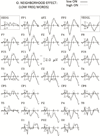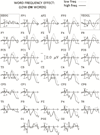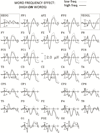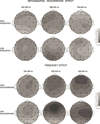Orthographic neighborhood effects as a function of word frequency: an event-related potential study
- PMID: 22803612
- PMCID: PMC3431195
- DOI: 10.1111/j.1469-8986.2012.01410.x
Orthographic neighborhood effects as a function of word frequency: an event-related potential study
Abstract
The present study assessed the mechanisms and time course by which orthographic neighborhood size (ON) influences visual word recognition. ERPs were recorded to words that varied in ON and in word frequency while participants performed a semantic categorization task. ON was measured with the Orthographic Levenshtein Distance (OLD20), a richer metric of orthographic similarity than the traditional Coltheart's N metric. The N400 effects of ON (260-500 ms) were larger and showed a different scalp distribution for low than for high frequency words, which is consistent with proposals that suggest lateral inhibitory mechanisms at a lexical level. The ERP ON effects had a shorter duration and different scalp distribution than the effects of word frequency (mainly observed between 380-600 ms) suggesting a transient activation of the subset of orthographically similar words in the lexical network compared to the impact of properties of the single words.
Copyright © 2012 Society for Psychophysiological Research.
Figures







Similar articles
-
Event-related brain potential evidence for early effects of neighborhood density in word recognition.Neuroreport. 2007 Dec 3;18(18):1957-61. doi: 10.1097/WNR.0b013e3282f202f5. Neuroreport. 2007. PMID: 18007194
-
Comparison of brain mechanisms underlying the processing of Chinese characters and pseudo-characters: an event-related potential study.Int J Psychol. 2010 Apr 1;45(2):102-10. doi: 10.1080/00207590903156439. Int J Psychol. 2010. PMID: 22043890
-
ERP manifestations of processing printed words at different psycholinguistic levels: time course and scalp distribution.J Cogn Neurosci. 1999 May;11(3):235-60. doi: 10.1162/089892999563373. J Cogn Neurosci. 1999. PMID: 10402254
-
Moving beyond Coltheart's N: a new measure of orthographic similarity.Psychon Bull Rev. 2008 Oct;15(5):971-9. doi: 10.3758/PBR.15.5.971. Psychon Bull Rev. 2008. PMID: 18926991
-
From sublexical facilitation to lexical competition: ERP effects of masked neighbor priming.Brain Res. 2018 Apr 15;1685:29-41. doi: 10.1016/j.brainres.2018.01.029. Epub 2018 Jan 31. Brain Res. 2018. PMID: 29407530 Free PMC article.
Cited by
-
The ERP signature of the contextual diversity effect in visual word recognition.Cogn Affect Behav Neurosci. 2017 Jun;17(3):461-474. doi: 10.3758/s13415-016-0491-7. Cogn Affect Behav Neurosci. 2017. PMID: 28050804
-
Orthographic neighborhood density modulates the size of transposed-letter priming effects.Cogn Affect Behav Neurosci. 2021 Oct;21(5):948-959. doi: 10.3758/s13415-021-00905-w. Epub 2021 May 6. Cogn Affect Behav Neurosci. 2021. PMID: 33954926
-
Effect of contextual diversity on word recognition in different semantic contexts.Psych J. 2024 Feb;13(1):44-54. doi: 10.1002/pchj.716. Epub 2023 Dec 17. Psych J. 2024. PMID: 38105595 Free PMC article.
-
The N400 and the fourth grade shift.Dev Sci. 2015 Mar;18(2):254-69. doi: 10.1111/desc.12212. Epub 2014 Jul 16. Dev Sci. 2015. PMID: 25041502 Free PMC article.
-
Task modulates ERP effects of orthographic neighborhood for pseudowords but not words.Neuropsychologia. 2019 Jun;129:385-396. doi: 10.1016/j.neuropsychologia.2019.02.014. Epub 2019 Feb 21. Neuropsychologia. 2019. PMID: 30797831 Free PMC article.
References
-
- Acha J, Perea M. The effect of neighborhood frequency in reading: Evidence with transposed-letter neighbors. Cognition. 2008;108:290–300. - PubMed
-
- Andrews S. Frequency and neighborhood effects on lexical access: Activation or search? Journal of Experimental Psychology: Learning, Memory and Cognition. 1989;15:802–814.
-
- Andrews S. Frequency and neighborhood effects on lexical access: Lexical similarity or orthographic redundancy? Journal of Experimental Psychology: Learning Memory and Cognition. 1992;18:234–254.
-
- Andrews S. The effect of orthographic similarity on lexical retrieval: Resolving neighborhood conflicts. Psychonomic Bulletin & Review. 1997;4:439–461.
-
- Balota DA, Chumbley JI. Are lexical decisions a good measure of lexical access? The role of word frequency in the neglected decision stage. Journal of Experimental Psychology: Human Perception and Performance. 1984;10:340–357. - PubMed
Publication types
MeSH terms
Grants and funding
LinkOut - more resources
Full Text Sources
Miscellaneous

